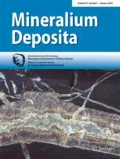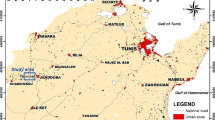Abstract
The Cu-Co-Au deposits of the Idaho Cobalt Belt are in lithostratigraphic zones of the Middle Proterozoic Yellowjacket Formation characterized by distinctive chemical and mineralogical compositions including high concentrations of Fe (15- > 30 wt. percent Fe2O3), Cl (0.1–1.10 wt. percent), and magnetite or biotite (> 50 vol. percent). The Cu-Co-Au deposits of the Blackbird mine are stratabound in Fe-silicate facies rocks that are rich in biotite, Fe, and Cl, but stratigraphically equivalent rocks farther than 10 km from ore deposits have similar compositions. A lower lithostratigraphic zone containing magnetite and small Cu-Co-Au deposits extends for more than 40 km. The Fe-rich strata are probably exhalative units related to mafic volcanism and submarine hot springs, but the origin of the high Cl concentrations is less clear. Former chlorine-rich pore fluids are suggested by the presence of supersaline fluid inclusions, by Cl-rich biotite and scapolite (as much as 1.87 percent Cl in Fe-rich biotite), and by high Cl concentrations in rock samples. Chlorine is enriched in specific strata and in zones characterized by soft-sediment deformation, thus probably was introduced during sedimentation or diagenesis. Unlike some metasedimentary rocks containing scapolite and high Cl, the Yellowjacket Formation lacks evidence for evaporitic strata that could have been a source of Cl. More likely, the Cl reflects a submarine brine that carried Fe, K, and base metals. Strata containing anomalous Fe-K-Cl are considered to be a guide to sub-basins favorable for the occurrence of stratiform base-metal deposits.
Similar content being viewed by others
References
Berndt, M.E., Seyfried, W.E., Jr. (1900) Boron, bromine, and other trace elements as clues to the fate of chlorine in mid-ocean ridge vent fluids. Geochimica et Cosmochimica Acta 54:2235–2245
Connor, J.J. (1990) Geochemical stratigraphy of the Yellowjacket Formation (Middle Proterozoic) in the area of the Idaho Cobalt Belt, Lemhi County, Idaho, Part A. Discussion: US Geological Survey Open-File Report 90-0234, 50 pp.
Connor, J.J. (1991) Some geochemical features of the Blackbird and Jackass zones of the Yellowjacket Formation (Middle Proterozoic) in east-central Idaho. US Geological Survey Open-File Report 91-0259, 25pp.
Connor, J.J., Evans, K.V. (1986) Geologic map of the Leesburg quadrangle, Lemhi County, Idaho: US Geological Survey Map MF-1880, Scale 1:62, 500
Evans, K.V., Zartman, R.E. (1990) U-Th-Pb and Rb-Sr geochronology of Middle Proterozoic granite and augen gneiss, Salmon River Mountains, east central Idaho. Geol Soc Am Bull 102:63–73
Franklin, J.M., Lydon, J.W., Sangster, D.F. (1981) Volcanic-associated massive sulfide deposits. Econ Geol 75th Anniversary Volume, pp. 485–627
Fuge, R. (1978) Chlorine, parts B-O. In: Wedepohl, K.H. (ed.) Handbook of geochemistry. Springer, Berlin Heidelberg, New York, pp. 17B-170
Graf, D.L. (1982) Chemical osmosis, reverse chemical osmosis, and the origin of subsurface brines. Geochimica et Cosmochimica Acta 46:1431–1448
Gross, G.A. (1980) A classification of iron formations based on depositional environments. Canadian Mineralogist 18:215–222
Grotzinger, J.P. (1986) Shallowing-upward cycles of the Wallace Formation, Belt Supergroup, northwestern Montana and northern Idaho. Montana Bureau Of Mines and Geology Special Publication 94:143–160
Guidotti, C.V. (1984) Mica in metamorphic rocks. In: Bailey, S.W. (ed.) Micas. Mineral Soc Am Rev Mineralogy 13:357–468
Hahn, G.A., Hughes, G.J., Jr., (1984) Sedimentation, tectonism, and associated magmatism of the Yellowjacket Formation in the Idaho Cobalt Belt, Lemhi County, Idaho. In: Hobbs, S.W. (ed.) The Belt. Belt Symposium II, 1983. Montana Bureau of Mines and Geology Special Publication 90:65–67
Hanor, J.S. (1979). The sedimentary genesis of hydrothermal fluids. In: Barnes, H. L. (ed.) Geochemistry of hydrothermal ore deposits, 2nd edn. Wiley, New York, pp. 137–172
Hardie, L.A. (1984) Evaporites: marine or non-marine. Am J Sci 284:193–240
Heitanen, A.H. (1967) Scapolite in the Belt Series in the St. Joe-Clearwater region, Idaho. Geol Soc Am Spec Paper 86: 56
Helgeson, H.C. (1968) Geologic and thermodynamic characteristics of the Salton Sea Geothermal System. Am J Sci 266:129–166
Hughes, G.J., Jr. (1983) Basinal setting of the Idaho Cobalt Belt, Blackbird mining district, Lemhi County, Idaho. In: The genesis of Rocky Mountain ore deposits-Changes with time and tectonics. Denver Region Exploration Geologists Society, pp. 21–27
James, H.L. (1954) Sedimentary facies of iron-formation. Econ Geol 49:235–293
Kalogeropoulos, S.I., Scott, S.D. (1983) Mineralogy and geochemistry of tuffaceous exhalites (tetsusekiei) of the Fukazawa mine, Hokuroku district, Japan. In: Ohmoto, H., Skinner, B.J., (eds.) The Kuroko and related volcanogenic massive sulfide deposits. Econ Geol Monogr 5:412–432
Lee, D.E. (1955) A chlorine-rich biotite from Lemhi County, Idaho. Am Mineralogist 43:107–111
Lydon, J.W. (1983) Chemical parameters controlling the origin and deposition of sediment-hosted stratiform lead-zinc deposits, In: Sangster, D.F. (ed.) Sediment-hosted stratiform lead-zinc deposits. Mineralogical Association of Canada, Short Course Handbook 8:175–250
Mora, C.I., Valley, J.W. (1989) Halogen-rich scapolite and biotite: implications for metamorphic fluid-rock interaction. Am Mineralogist 74:721–737
Nash, J.T. (1989a) Chlorine-rich biotites from the Blackbird mining district, Lemhi County, Idaho-Evidence for a saline hydrothermal brine. US Geological Survey Open-File Report 89-445, 25 pp.
Nash, J.T. (1989b) Geology and geochemistry of synsedimentary cobaltiferous pyrite deposits, Iron Creek, Lemhi County, Idaho. US Geological Survey Bulletin 1882, 33 pp.
Nash, J.T, Hahn, G.A. (1989) Stratabound Co-Cu deposits and mafic volcaniclastic rocks in the Blackbird mining district, Lemhi County, Idaho. In: Boyle, R.W. et al. (eds.) Sediment-hosted stratiform copper deposits. Geol Assoc Can Spec Paper 36:339–356
Nash, J.T., Connor, J.J., Curry, K.J., Papp, C.S. (1990) Anomalous chlorine in iron-rich strata, Yellowjacket Formation, Lemhi County, Idaho; analytical data and discussion. US Geological Survey Open-File Report 90–721, 36 pp.
Palmer, M.R., Slack, J.F. (1989) Boron isotopic composition of tourmaline from massive sulfide deposits and tourmalinites. Contribution to Mineralogy and Petrology 103:434–451
Rehtijarvi, P. (1984) Enrichment of bromine and chlorine in Proterozoic serpentinites from the Outokumpu Cu-Co ore district, Finland. Econ Geol 79:549–552
Rona, P.C. (1988) Hydrothermal mineralization at oceanic ridges. Canadian Mineralogist 26:431–465
Schreiber, B.C. (1986) Arid shorelines and evaporites, In: Reading, H.G. (ed.) Sedimentary environments and facies, 2nd edn. Blackwell, London, pp. 189–228
Serdyuchenko, D.P. (1975) Some Precambrian scapolite-bearing rocks evolved from evaporites. Lithos 8:1–7
Slack, J.F., Herriman, N., Barnes, R.G., Plimer, I.R. (1984) Stratiform tourmalinites in metamorphic terranes and their geologic significance. Geology 12:713–716
Sorensen, H. (1986) The alkaline rocks- a review. Fortschr Mineralogie, 64:63–88
Springer, G. (1989) Chlorine-bearing and other uncommon minerals in the Strathcona deep copper zone, Sudbury district, Ontario. Canadian Mineralogist 27:311–313
Zierenberg, R.A. (1990) Deposition of metalliferous sediment beneath a brine pool in the Atlantis II Deep, Red Sea. In: McMurray, G.R. (ed.) Gorda Ridge. A seafloor spreading center in the United States' Exclusive Economic Zone. Springer, Berlin Heidelberg, New York, pp. 131–142
Zierenberg, R.A., Shanks, W.C., III (1988) Isotopic studies of epigenetic features in metalliferous sediment, Atlantis II Deep, Red Sea. Canadian Mineralogist 26:737–753
Author information
Authors and Affiliations
Rights and permissions
About this article
Cite this article
Nash, J.T., Connor, J.J. Iron and chlorine as guides to stratiform Cu-Co-Au deposits, Idaho Cobalt Belt, USA. Mineral. Deposita 28, 99–106 (1993). https://doi.org/10.1007/BF00196334
Received:
Accepted:
Issue Date:
DOI: https://doi.org/10.1007/BF00196334




